By: Rick Landers
Eric Clapton is the consummate modern blues guitarist, but one who can span the music universe and cast a magical spell with a nuanced bend, a funky riff or a scorching lead. He shares a historic legacy as a member of the legendary Yardbirds guitar hero triptych, with Jeff Beck and Jimmy Page. Clapton’s thoughtful and masterful guitar legacy resides in the discography of that milestone group, as well as John Mayall’s Bluesbreakers, Blind Faith, Cream, Derek and the Dominos, and Delaney, Bonnie & Friends. His debut solo album, Eric Clapton, didn’t gain much traction, but his 1974 followup, 461 Ocean Boulevard, charted to #1 on Billboard.
One of the proudest contributions Eric has given music is his acknowledgement and promotion of the pioneers of the blues, such as Robert Johnson, B.B. King, Buddy Guy and others who may have been forgotten in a world that wrapped itself in rock ‘n’ roll. He has also complemented any ambition he might have with altruism, as he established and supports The Crossroads Center and has contributed to Amnesty International, Live Aid, Asian Tsunami Relief, The T.J. Martell Foundation, relief for Bengladesh, UNICEF, and countless other worthy causes.
All of this making Eric Clapton an easy choice for our Guitar Hero Series.
******
Eric Patrick Clapton was born at the end of World War II, on March 30, 1945, in the small village of Ripley in Surrey, England. His mother, Patricia Molly Clapton, was 16 years old when Eric was born and was not able to care for the boy, who was raised by his grandparents Jack and Rose Clapp. Eric’s father, a 24-year old Canadian soldier who had been stationed in England during the war, returned to Canada and to his wife. Eric’s mother would marry and move to Canada with her husband, Frank McDonald, while Eric was nurtured by Jack and Rose. Eric’s background would remain obscure to him until he was nine years old, when his mother returned to England with Eric’s half-brother, Brian McDonald.
Like many English lads during the 1950s, Eric was enthralled with the new sound of rock ‘n’ roll and in 1958, he would ask for a guitar for his birthday. His first guitar, an acoustic Hoyer, arrived with heavy steel strings making it difficult, if not painful, to play, so the young boy put the guitar aside. A few years later he would immerse himself in the blues and guitar, so much so that he ignored his school studies and was kicked out of the Kingston School of Art.
In 1962, Eric would ask his grandparents for help in buying a Kay Red Devil, double cutaway electric guitar that was similar to the more expensive Gibson ES-335. The die was cast, and Clapton would begin to evolve into a guitar player, studying the music of the great blues masters like Muddy Waters, B.B. King, Buddy Guy, and Freddie King. His love of the blues would complement the interests of a few other lads who’s first gig was at the Kingston School of Art, who had formed a group with Anthony Top Topham on lead guitar. The group was first called the Metropolis Blues Quartet, then the Blue-Sounds, before settling on The Yardbirds. Eric would replace Topham as lead guitarist for The Yardbirds in October 1963.
 The Yardbirds would sign on to EMI’s Colombia label in February of 1964, a mere four months after Eric had joined the group. In December of that year, the group would release its first album, Five Live Yardbirds. The group would also roll out two singles, “I Wish You Would,” a song written in 1955 by bluesman Billy Boy Arnold, and “Good Morning Little Schoolgirl,” a number first recorded in the 1930s by Sonny Boy Williamson I. The Yardbird’s version would reach #44 on the U.K. charts. But, it would take “For Your Love,” a song written by Graham Gouldman, to get The Yardbirds world-wide recognition, one million records sold and a gold platter.
The Yardbirds would sign on to EMI’s Colombia label in February of 1964, a mere four months after Eric had joined the group. In December of that year, the group would release its first album, Five Live Yardbirds. The group would also roll out two singles, “I Wish You Would,” a song written in 1955 by bluesman Billy Boy Arnold, and “Good Morning Little Schoolgirl,” a number first recorded in the 1930s by Sonny Boy Williamson I. The Yardbird’s version would reach #44 on the U.K. charts. But, it would take “For Your Love,” a song written by Graham Gouldman, to get The Yardbirds world-wide recognition, one million records sold and a gold platter.
Around this time, Eric was given the nickname “Slowhand”, after audiences would begin to clap slowly while he changed broken strings and re-tune his guitar in the middle of a song. As a traditional blues purist, Clapton was troubled by the group’s move away from the blues and left the group, at a defining moment in the band’s legendary career. Eric would join up with John Mayall & the Bluesbreakers. The Yardbirds would replace Eric with Jimmy Page, and later Jeff Beck would join the group.
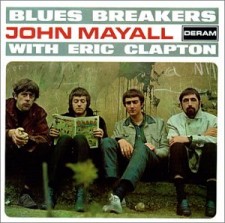 Having left the Yardbirds, Clapton was ready to stick to his first love, the blues, and John Mayall was a die-hard blues man. Clapton’s stint with the Bluesbreakers didn’t last long, and he was gone within a few months. He joined a group called The Glands, before returning to John Mayall & the Bluesbreakers in the summer of 1965.
Having left the Yardbirds, Clapton was ready to stick to his first love, the blues, and John Mayall was a die-hard blues man. Clapton’s stint with the Bluesbreakers didn’t last long, and he was gone within a few months. He joined a group called The Glands, before returning to John Mayall & the Bluesbreakers in the summer of 1965.
He was back to his roots and it was during this time that Clapton earned his reputation as the best guitarist in the U.K., and the legend grew after a fan spray painted the phrase “Clapton is God” near an Underground station in Islington in the mid-60s. Clapton can be seen on the John Mayall & the Bluesbreakers (w/Eric Clapton) album that’s referred to as “The Beano Album,” as the front of the album cover shows Eric reading a “Beano” comic and appears seemingly uninterested in the photo shoot for an album that reached the #6 spot on U.K. charts.
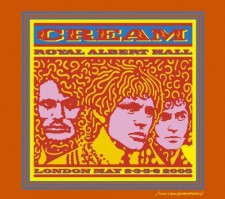 The impact of the powerhouse trio, Cream, was enormous. When blues men Eric Clapton (guitar), Peter “Ginger” Baker (drums) and Jack Bruce (bass) the volatile relationship between Baker and Bruce was channeled into some of the best blues-jazz-psychedelic rock fusion ever produced. With Eric on hand to try to keep the band balanced, Cream would produce such monster tracks as “White Room,” “Sunshine of Your Love,” “Tales of Brave Ulysses,” “Crossroads,” “I’m So Glad,” “Strange Brew,” “SWLABR,” “Born Under a Bad Sign,” “Spoonful,” “Badge” and “Those Were The Days.”
The impact of the powerhouse trio, Cream, was enormous. When blues men Eric Clapton (guitar), Peter “Ginger” Baker (drums) and Jack Bruce (bass) the volatile relationship between Baker and Bruce was channeled into some of the best blues-jazz-psychedelic rock fusion ever produced. With Eric on hand to try to keep the band balanced, Cream would produce such monster tracks as “White Room,” “Sunshine of Your Love,” “Tales of Brave Ulysses,” “Crossroads,” “I’m So Glad,” “Strange Brew,” “SWLABR,” “Born Under a Bad Sign,” “Spoonful,” “Badge” and “Those Were The Days.”
The group’s now legendary albums include Disraeli Gears, Wheels of Fire and Fresh Cream. Wheels of Fire was the first double album to go platinum, and in their short existence Cream sold over 35 million albums. By mid-1968, the trio was ready to call it quits with Baker recalling in a 2006 interview in Music Mart magazine:
“It just got to the point where Eric said to me, ‘I’ve had enough of this,’ and I said, “So have I. I couldn’t stand it. The last year with Cream was just agony. It damaged my hearing permanently, and today I’ve still got a hearing problem because of the sheer volume throughout the last year of Cream. But, it didn’t start off like that. In 1966, it was great. It was really a wonderful experience musically, and it just went into the realms of stupidity.”
Blind Faith was a bluesy quartet that included Eric on lead guitar, Ric Grec (bass), Ginger Baker (drums) and Stevie Winwood (vocals/keyboards). Their first and only release, a self-titled blockbuster that hit the #1 spot in both the U.S. and the U.K. drew international acclaim and a controversial stir, given the nude pubescent girl on the cover holding a silver space ship that some claimed was too phallic for public consumption.
In the States, the cover would be different, with a photo of the band members. The group would soon splinter apart, with Eric hanging out with John Lennon and The Plastic Ono Band and later with Delaney & Bonnie & Friends. Both seemed to suit Clapton’s nature better than his superstardom fame with Cream and Blind Faith. Eric would continue to play some of the Blind Faith tunes throughout his career including, “Can’t Find My Way Home” and “In the Presence of the Lord.”
Guitarist Delaney Bramlett and keyboardist Leon Russel formed Delaney & Bonnie & Friends with Delaney’s wife, singer Bonnie Bramlett, who served some time as one of Ike Turner’s Ikettes when she was 15. The group worked as the opening act for Blind Faith and Clapton enjoyed working with the band. With the breakup of Blind Faith, Eric would play as a sideman for Delaney & Bonnie & Friends until he moved in his own direction to establish Derek and the Dominos in 1970.
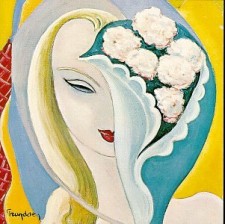 This short-lived group included Clapton as well as two members from Delaney & Bonnie & Friends, keyboardist, Bobby Whitlock, drummer, Jim Gordon; and bassist, Carl Riddle. The band would only release a single album, Layla and Other Assorted Love Songs, with guitarist Duane Allman, from the Southern Rock group, The Allman Brothers, heavily featured on the album, most notably on the mega-hit “Layla.”
This short-lived group included Clapton as well as two members from Delaney & Bonnie & Friends, keyboardist, Bobby Whitlock, drummer, Jim Gordon; and bassist, Carl Riddle. The band would only release a single album, Layla and Other Assorted Love Songs, with guitarist Duane Allman, from the Southern Rock group, The Allman Brothers, heavily featured on the album, most notably on the mega-hit “Layla.”
“Layla” was written by Clapton as a tribute to George Harrison’s wife, Pattie Boyd Harrison, who captured Clapton’s fascination, if not infatuation. The name of the group was based on Eric being referred to as Derek during his stint with Delaney & Bonnie, and a brainstorming session where Fats Domino’s name came up in the name game. When the group’s album came out, it was a flop. No one knew Clapton was on the album.
It was only after “Layla” was released in 1972 by Atlantic records did the album get notice, as “Layla” exploded up the charts to #10 in the U.S. and #7 in the U.K. The album is now recognized as one of the best albums of all time by Rolling Stone that ranked it #115 and VH1 citing it as #89.
During the mid-‘70s, Clapton began to emerge more as a solo artist, joining friends in collaborations, as well as running to ground in his personal life, before he got into a vibe of running on faith. His celebrity offered him fame and fortune, but away from the spotlight Eric would find himself longing for his friend’s wife, Pattie Boyd. Eric would also be burdened by the siren of addiction. Heroin would wreak havoc before he was able to loosen its grip, but then he also had an addiction to alcohol that would offer no solace to whatever deep-seated compulsion drove him to self-destruction.
He seemed to find balance when he turned out his second solo album, 461 Ocean Boulevard, a superb set of tracks. 461 Ocean Boulevard is the rental house that Clapton lived in during that time. The album reflected a maturity and a sense of direction to the blues-rocker, and gave him a #1 solo hit, Bob Marley’s “I Shot the Sheriff.” While many of his fans would prefer to have Clapton roll back to his Cream days, his career as a solo artist has allowed him greater freedom to navigate his musical journey.
Eric would marry George Harrison’s ex-wife Pattie Boyd and roll out his low key efforts like the 1975 album No Reason to Cry, There’s One in Every Crowd, E.C. Was Here and Slowhand.
During a 1976 concert in Birmingham, England, Clapton unleashed a bellicose racist rant about immigrants in the U.K., which were very unsettling, if not peculiar, given his well-known support of African-American blues masters. Eric has denied that he is a racist, stating, “There’s no way I’m a racist. It would make no sense.”
In his recent autobiography, he added, that he was “deliberately oblivious to it all. I had never really understood or been directly affected by racial conflict… when I listened to music, I was disinterested in where the players came from or what colour their skin was.”
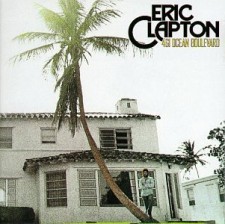 It seemed that Clapton turned another corner in his music when he supported Amnesty International with a stage appearance at The Secret Policemen’s Other Ball in 1981. He would join his fellow ex-Yardbird, Jeff Beck, on stage for a rousing performance of duets where the two traded licks. But, his personal life went awry again due to his alcoholism and he re-committed to getting clean.
It seemed that Clapton turned another corner in his music when he supported Amnesty International with a stage appearance at The Secret Policemen’s Other Ball in 1981. He would join his fellow ex-Yardbird, Jeff Beck, on stage for a rousing performance of duets where the two traded licks. But, his personal life went awry again due to his alcoholism and he re-committed to getting clean.
As an avid fisherman Eric found the embarrassment of having stumbled and breaking a new fishing rod, too much to bear and an awakening that he needed to get sober. He noted, “That was it for me. The last vestige of my self-esteem had been ripped away. In my mind being a good fisherman was the last place where I still had some self-esteem.”
But, the ‘80s Clapton fans did not do without, as he released several albums including, Just One Night, Another Ticket, Time Pieces, Time Pieces Vol 2., and Behind the Sun. Possibly the most challenging of these for Eric, was one he released after undergoing a 12-step rehab program at the Hazeden Treatment Center in Minnesota.
The album released in February 1983, Money and Cigarettes, he has stated seemed “forced,” even with a top notch backing group that included Ry Cooder, Albert Lee and Donald “Duck” Dunn. The record wouldn’t gain heavy airtime, but claimed a #16 spot on Billboard. Eric would also branch out, by teaming up with the late Michael Kaman for the soundtrack of the hit film, Lethal Weapon 1.
Eric would launch a series of 32 concerts during the early ‘90s at the Royal Albert Hall in London and, subsequently releasing a live album of the concerts called 24 Nights, featuring what he considered some of the best performances of the RAH concerts. The concerts would be another highlight of Clapton’s career, in yet another collaboration released on Duck Records, with Michael Kaman who led the National Philharmonic Orchestra. But, the trials and tribulations of life continued to haunt Clapton with the death of the American blues guitarist, Stevie Ray Vaughan, who died in a helicopter crash after sharing the stage with Eric, Robert Cray, Buddy Guy and Stevie’s brother, Jimmie Vaughan, on August 26, 1990 at the Alpine Valley Music Theater, East Troy, Wisconsin.
Seven months later, Eric would lose his five year old son, Conor, to a tragic accident. Clapton would release some of his emotions on a song written with Will Jennings, in Conor’s honor, “Tears in Heaven.” The album, Unplugged, and the consoling single would gather six Grammy awards. Eric would later perform with other heavy hitter musicians; George Harrison, Tom Petty, Steve Cropper, Neil Young, Roger McGuinn and Bob Dylan in Madison Square Garden for Dylan’s 30th Anniversary Concert Celebration.
By 1997, Eric would grab another Grammy award for his beautiful song, “Change the World.” More collaborations would follow with his then girlfriend, Sheryl Crow, Carlos Santana and bluesman B.B. King. Eric would meet a young American, Melia McEnery in 1999, who was told that Eric Clapton was in the retail shop where she was working and she said, “Who’s Eric Clapton?” They married three years later and today have three daughters. His 2006 album The Road to Escondido includes the track “Three Little Girls,” which honors his new family.
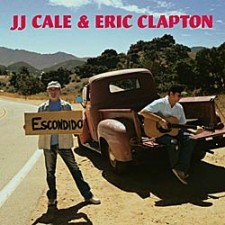 Eric started out the next decade with a new album that reached gold certification in 2001, Reptile, with keyboardist Billy Preston helping out, along with the ‘50s classic Rock ‘n’ Roll Hall of Fame inductees, The Impressions, a group that had once included the legendary Curtis Mayfield.
Eric started out the next decade with a new album that reached gold certification in 2001, Reptile, with keyboardist Billy Preston helping out, along with the ‘50s classic Rock ‘n’ Roll Hall of Fame inductees, The Impressions, a group that had once included the legendary Curtis Mayfield.
During the decade, Clapton would collaborate with a series of superb artists that included: Jeff Beck, Derek Trucks, John Mayer, Paul McCartney, Ringo Starr, Stevie Winwood, Jools Holland, Sheryl Crow, Roger Walters, J.J. Cale, Roger Taylor and Joe Bonamassa. His concert appearances included the Concert for George, a tribute show for his musical cohort and friend, the late George Harrison.
Eric would also stage his own Crossroads Concerts with some of his friends that include; Robert Cray, Jimmie Vaughan, John Mayer and top guitarists. There have been many books written about Clapton including, Clapton – An Authorized Biography (Ray Coleman – 1986); Eric Clapton – A Biography (John Pidgeon – 1976); Slowhand – The Life and Music of Eric Clapton (Marc Robert – 1991) and Clapton – Edge of Darkness (Christopher Sandford – 1994) and others.
But, in 2007 Eric finished up a book with author Christopher Simon Sykes, Clapton-The Autobiography, which lays down his life as he sees it, and quickly became a top seller worldwide.
Today, Eric continues to wow audiences with his stunning performances and continues to support his Crossroads Center. In December 2010, his press agent announced that more than 70 guitars from his personal collection will be auctioned in early 2010, along with 70 of his amps, with proceeds benefiting the Center in Antigua.
Eric’s run through scores of guitars, including his original Hoya acoustic, a Washburn acoustic and a low end Kay Red Devil that he purchased in his teens. His most notable guitars include his Cherry Red Gibson ES-335, the famous psychedelic-colored Gibson SG named “The Fool,” as well as a couple of Fender Stratocasters known as “Brownie” and “Blackie.”
Along the way, Eric has also owned a series of Fender Stratocasters, Telecasters, and Jaguars. His early Gibson Les Pauls have included bursts and black models dating from 1958 to 1961. Eric’s also used Gibson Firebirds while with Cream and Blind Faith. On acoustic, Clapton has used Gibsons, Guilds and Martins. Below is a short-list of Clapton’s gear.
• Yardbirds: Fender Telecaster, Fender Jazzmaster, Fender Jaguar, Gibson ES-335. Marshall JTM-45 Fullstack and Vox AC-30 Combo.
• Bluesbreakers: Fender Telecaster, Gibson Les Paul (Red – 1958/1960) (Sunburst – 1958/1959); Marshall Custom JTM-45 Top Combo.
• Cream: Gibson SG (The Fool); Les Paul Custom (Black – 1958/1961), Gibson ES-335; 1963 Gibson Firebird.
• Blind Faith: Fender Telecaster, Fender Stratocaster, Gibson ES-335, Gibson Firebird, Epiphone 12-string acoustic, Guild 12-string acoustic.
• Delaney & Bonnie: Fender Stratocaster, Gibson Firebird, Gibson Les Paul.
• Derek & The Dominos: Fender Stratocaster named “Brownie.”
• Solo: Fender Stratocaster named “Blackie” (Eric built this Stratocaster from three guitars he bought a Gruhn’s in Nashville). Red Gibson ES-335 (1964); Fender Stratocaster Eric Clapton Signature models; Fender Dual Showman; Fender Twin Reverb (Pre-1968 models).
Click to Visit the Eric Clapton Collection at Amazon.com
• 461 Ocean Boulevard (1974)
• Unplugged (1992)
• From the Cradle (1995)
• The Blues (1999)
• Riding with the King (2000)
• Me and Mr. Johnson (2004)
• I Shot the Sheriff (1974)
• I Can’t Stand It (1981)
• Forever Man (1985)
• It’s In The Way That You Use It (1987)
• Pretending (1989)
• Bad Love (1990)
• Tears in Heaven (1992)
• Change the World (1996)

Eric Clapton Official Website
Where’s Eric? Eric Clapton Fan Website
Clapton: The Autobiography
Wonderful Tonight: George Harrison, Eric Clapton, and Me
Clapton’s Guitar: Watching Wayne Henderson Build the Perfect Instrument
Guitar Hero Series: Eric Clapton – Guitar International | Guitar Info Zone (13 years ago)
[…] Original post click here […]
Tweets that mention Guitar Hero Series: Eric Clapton | Guitar International Magazine -- Topsy.com (13 years ago)
[…] This post was mentioned on Twitter by MusicPro Magazine, Matthew Warnock, Guitar Hero Fans, Michael Jones, Pierre Johnson and others. Pierre Johnson said: Guitar Hero Series: Eric Clapton http://bit.ly/i7waqn […]
A Concert By the Lake: Ringo Starr, Eric Clapton and More | Guitar International Magazine (13 years ago)
[…] night was also chockfull of guest appearances, including Eric Clapton (“Lay Down Sally,” “Willie & The Hand Jive,” “Cocaine”), Ringo […]
Peter Bursch Interview | Guitar International Magazine (13 years ago)
[…] You’re right, before me Eric Clapton and Mark Knopfler had received their own Martins. Anyway, I got very excited about the idea and I […]
Robert M. Knight: Interview with a Rock Photography Icon | Guitar International Magazine (13 years ago)
[…] up its unreal. Ryan McGarvey’s band is fantastic and Ryan won the best guitar player and played Eric Clapton’s Crossroads as the […]
This is the Blues Volume 3 and 4 Review | Guitar International Magazine (13 years ago)
[…] Playing guitar on the track “Drifting,” alongside band mates Jim McCarty and Andy Cleveland, Topham lays down some great guitar work, not the best on the record, but memorable none the less. If some of our readers are scratching their heads at this point trying to remember where they’ve see Top’s name before, he was the original guitarist for The Yardbirds, before leaving to be replaced by Slowhand himself, Eric Clapton. […]
Gibson Eric Clapton 1960 Les Paul : NAMM Show | Guitar International Magazine (13 years ago)
[…] soon as we walked into the door at Gibson’s 2011 NAMM show exhibit we ran right into the Eric Clapton 1960 Les Paul Reissue. The guitar is easy on the eyes, to say the least, and though we didn’t get […]
This is the Blues Volume 3 and 4 Review : Guitar Reviews : Blues | GuitarInternational.com (13 years ago)
[…] Playing guitar on the track “Drifting,” alongside band mates Jim McCarty and Andy Cleveland, Topham lays down some great guitar work, not the best on the record, but memorable none the less. If some of our readers are scratching their heads at this point trying to remember where they’ve see Top’s name before, he was the original guitarist for The Yardbirds, before leaving to be replaced by Slowhand himself, Eric Clapton. […]
Peter Bursch Interview : Guitar Interviews : Fingerstyle | GuitarInternational.com (13 years ago)
[…] You’re right, before me Eric Clapton and Mark Knopfler had received their own Martins. Anyway, I got very excited about the idea and I […]
Joe Bonamassa Interview : Guitar Interviews : Blues | GuitarInternational.com (13 years ago)
[…] on weekends, pull stuff out, and listen to it. Most of it was blues, and stuff like Peter Green, Eric Clapton, Bluesbreaker stuff, Paul Kossoff, and Jeff […]
Johnny Winter Interview : Guitar Interviews : Classic Rock | GuitarInternational.com (13 years ago)
[…] During the summer you played with Eric Clapton and fellow guitar legends at the Crossroads concert. What were the highlights of that […]
Joanne Shaw Taylor Interview : Guitar Interviews : Blues | GuitarInternational.com (13 years ago)
[…] legends such as Rory Gallagher, Jimmy Page, Eric Clapton and Jeff Beck are just a few of the countless U.K. artists who were influenced by American Blues, […]
pedalbender.com | Blog | Mike Eldred Interview: Behind the Scenes with the Eric Clapton Sun Strat (13 years ago)
[…] millions of people around the world would probably like to thank Eric Clapton for the pleasure his music has added to their life, there are those with something more precious to […]
Jensen Lee (13 years ago)
There is word that the Yardbirds may reunite; if Clapton ever relented, it would be an unbelieveable lineup.
I recently posted on my Rockaeology blog at http://tinyurl.com/5s2hjls the story behind “For Your Love.”
As you wrote, the success of the song convinced Clapton to leave the group. Frustrated that the music was becoming too commercial, Clapton reportedly bristled at having to perform the song’s harpsichord riff (played by Brian Auger on the record) on a 12-string guitar.
Guitar International Magazine (13 years ago)
Very cool, we just interviewed Top Topham and will have it up this month, a lot of interesting things to say about the early yardbirds and where they went after he left, classic group!